Index


Review: Stylish in blue and a good all rounder
It has been quite a while since our first Gigabyte review. Luckily, we received one of the first Ultra Durable 3 boards with 2 oz. copper layers. Now it's time to find out if the whole 2 oz. story is just another marketing hoax or if more copper in the PCB really does improve overclocking.
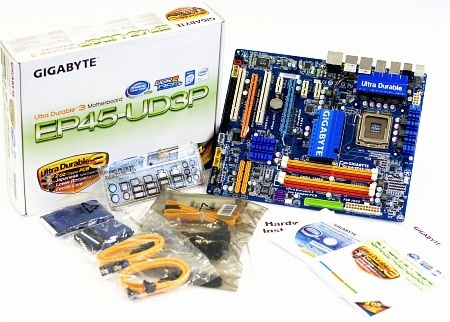
Features:
Intel P45/iCH10R
6-phase VRM
Realtek ALC889A
Realtek RTL8111C x2 PCIe Gb LAN controller
JMB363 SATA II RAID 0, 1/IDE controller
ITE IT8718F-S super I/O controller
TI TSB43AB23 Firewire controller
ICS9LPRS914EKLF clock generator
passive cooling of chipsets/VRM
8Mb BIOS, version F5
Mainboard Revision: 1.0
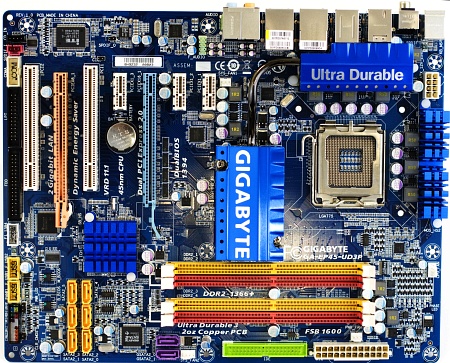
Slots:
2x PCIe 2.0 x16
3x PCIe x1
2x PCI
Memory:
4x Dual-Channel DDR2-slots for PC2-6400U memory up to 8GB
Storage:
6-Port SATA II featuring RAID 0, 1, 5, 0+1, JBOD
1-Port IDE
2-Port SATA II RAID 0,1, 0+1, JBOD
Backpanel ports:
1x PS/2 keyboard
1x PS/2 mouse
2x Gb LAN
8x USB 2.0
2x Firewire
7.1 analog output
1x SP/DIF digital out
1x SP/DIF coaxial out

Accessories:
4x SATA cable (2 angeled 90°)
1x eSATA bracket with 2x eSATA & 1x HDD power
1x eSATA cable
1x HDD power of SATA power
1x Floppy cable
1x IDE cable
BIOS features:
Bus Speeds: Auto, 100MHz to 1200MHz in 1MHz increments
Memory Ratios: Auto, fixed ratios: 1:1, 1:1.2, 1:1.25, 1.50, 1.60, 1.66, 1:2 depending on FSB/strap
FSB Strap: hidden, linked with Memory Ratio, 200MHz, 266MHz, 333MHz, 400MHz
DRAM command rate: Auto, 1T, 2T
DRAM timing control: Auto, manual
PCIe Frequency: Auto, 90 to 150 MHz in 1MHz increments
CPU Clock Multiplier: Auto, manual
Core 2 Duo: 6x-11x in 0.5x increments - Core-2 Duo, downwards unlocked
Core 2 Extreme: 6x-16X, downwards unlocked
CPU Voltage: auto, 0.5000V to 1.6000V in 0.00625V increments, 1.60V to 2.30V in 0.02V increments
CPU PLL Voltage: Auto, 1.05V to 1.50V in 0.05V increments, 1.57V to 2.81V in 0.02V increments
DRAM Voltage: Auto, normal, 1.45V to 1.80V in 0.05V increments, 1.80V to 3.04V in 0.02V increments
FSB Termination Voltage: Auto, normal, 1.10V, 1.20V to 1.70V in 0.02V increments
Northbridge Voltage: Auto, normal, 0.85V to 1.10V in 0.05V increments, 1.16V to 2.00V in 0.02V increments
Testbed:
Motherboard:
Gigabyte GA-EP45-UD3P (provided by Gigabyte)
Intel P45/iCH10R
CPU:
Intel Core-2 Duo E8400
CPU-Cooler:
Scythe Andy Samurai Master (provided by Scythe-Europe)
Memory:
Kingston 2GB Kit PC2-9600U KHX1200D2K2/2G (provided by Kingston)
CL5-5-5-15 CR2T at 1.80V
Graphics Card:
Jetway Radeon HD3870 (provided by mec-electronics)
Power supply:
Seasonic S12II 500W
Hard disk:
Western Digital WD4000KD (provided by Ditech)
Case fans:
SilenX iXtrema Pro 14dB(A) (provided by PC-Cooling.at)
Scythe DFS122512LS
Case:
Cooler Master Stacker 831 Lite (provided by Cooler Master)
Layout:
The first surprise are the blue heatsinks, which are new in the market. While we have seen tons of boards with copper colored heatsinks, even when they are all made of aluminium, with some exceptions by Gigabyte, this board does not appear to show off. It still looks stylish and it appeals to our eyes.
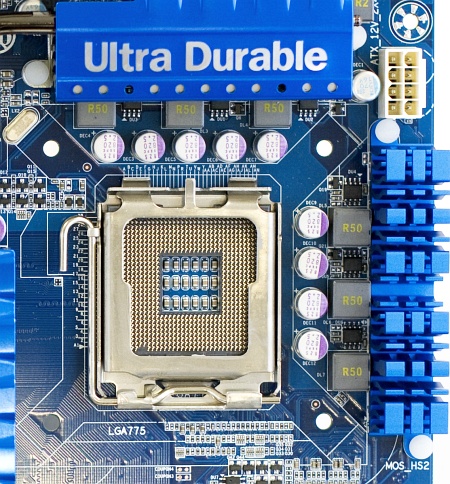
The VRM is an analog 6-phase design driven by an ISL6336. This is the same controller family that powers MSI's DRMOS, but the implementation is just not that good as MSI has done - except MSI does turn off this feature by default.
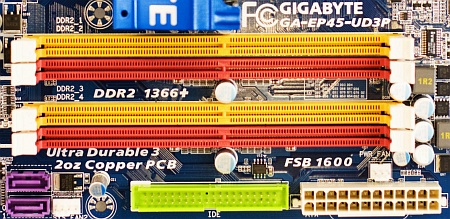
The memory slots are well placed. They are far away from the PCIe x16 slot, so you can change the memory with the graphics cards installed. The power and IDE connectors are placed beneath. The floppy-connector has been moved to the outer left of the board, because Gigabyte was one of the first vendors to allow flashing from an USB flash drive, so we will not miss the floppy-connector at all.
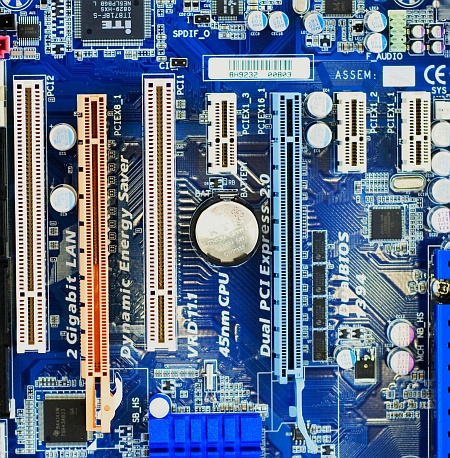
The slots are configured well. If you like to use a CrossFire setup on most boards you lose all additional slots. Not on this board. Even with two dual-slot cards installed, you still have two PCIe x1 and one PCI, that is clever.
For some reason all vendors go for the cheapest PCIe Gb LAN solution on the market, which is the Realtek RTL8111C. It is not known for very good performance, especially the I/O load is quite weak. A Marvell, Broadcom or Intel chip would have been a better choice, but of course opting for a better chip would also have increased costs. Audio is also provided by a Realtek chip: the ALC889A. We are not able to determine the difference between ALC888 and ALC889A, because the Realtek Webpage doesn't say anything about it. It seems it's just a custom design for Gigabyte with no real difference. The ITE chip is a super I/O controller, for all legacy devices, such as floppy, LPT and COM ports. The so called "Gigabyte SATA2" chip is a JMicro JMB363. We would have liked if Gigabyte had used them for two eSATA ports on the back-panel, but the package includes a SATA to eSATA bracket which will do fine, too.
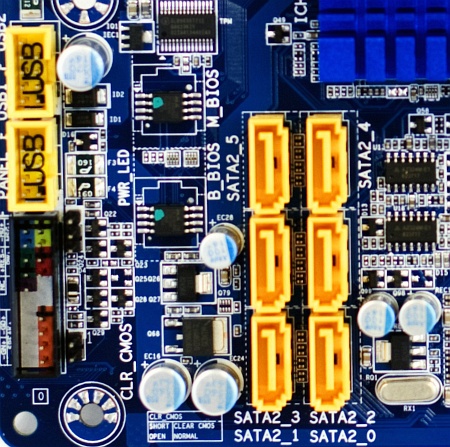
The SATA connectors are not on the edge of the board. Instead, the SATA connectors are placed behind the second PCIe x16 slot. We do not like that much. In case you buy a three-slot graphics-cards such as the new Gainward Rampage you will run into trouble, because the card will block three of the six connectors. So, next time we hope Gigabyte is using angled SATA connectors which do not interfere with any cards.
BIOS:
Gigabyte is using a plain AWARD 1MB BIOS. Last time we wrote about it we said that hiding any setting was quite a silly decision, and in the meantime Gigabyte promised they would change it and they did. Of course, many vendors have a habit of enabling COM1 and LPT, which are not used any more. Also, they do not include a COM/LPT bracket in the package. Also, the "overvoltage" and "deovervoltage" settings have been removed. Just plain simple voltage settings, that's how we like it.
FSB-Overclocking:
The EP45-UD3P did very well. It reached 550MHz FSB, but it would not go any further, but in this price category it's still unmatched.
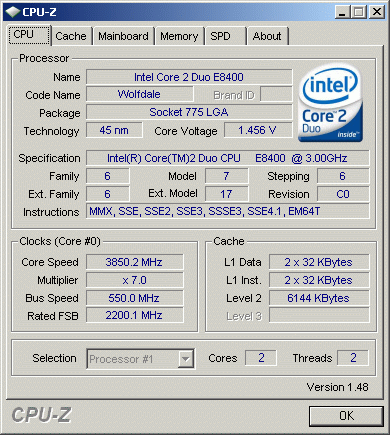
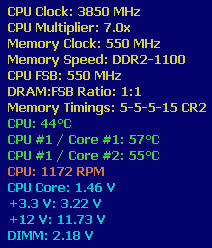
CPU-overclocking:
It was not difficult to reach 4.40GHz. We set the VCore to 1.6000V, enabled Loadline Calibration - a feature we missed testing the EP35 series. The VCore dropped to 1.568V. We know the sensors are not very exact, but the VRM keeps inside Intel specifications.
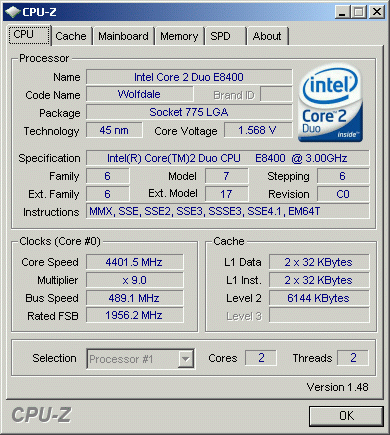
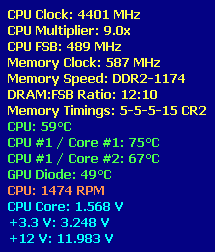
Memory-overclocking:
Gigabyte hasn't got the best reputation when it comes to memory overclocking. While the EP35 series was marked with 1200MHz this board says it can do 1366+MHz. 1200MHz was not a problem.
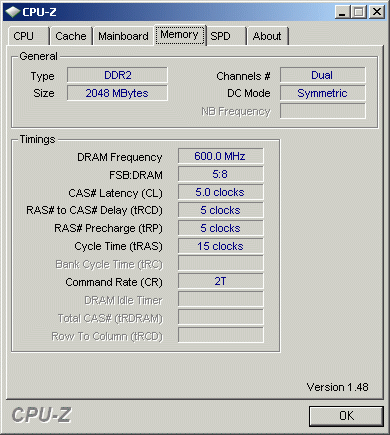
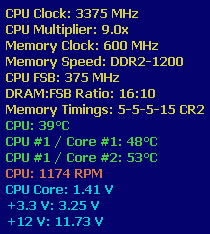
Because we have no higher clocking DDR2 kit, we eased the memory latencies to 6-6-6-18 and set them to 1333MHz and it worked without trouble, so it seems more copper inside the PCB does benefit overclocking after all.
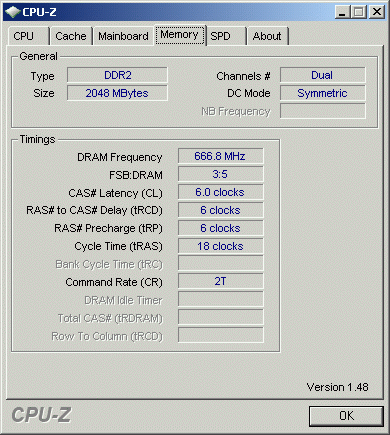
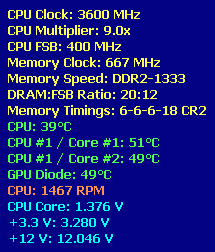
FSB BIOS clocking:
We have to state that we always recalculate the bench results to nominal frequencies. Most vendors do an overclock to their products, maybe to get more bench points, but we nullify such attempts. The Gigabyte is quite close to the nominal speeds:
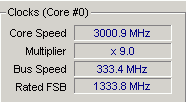
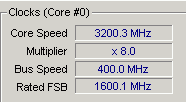
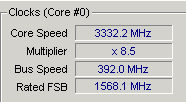
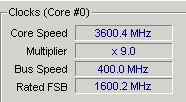
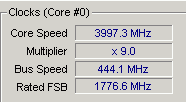
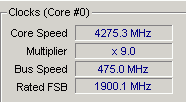
Benchmarks:
Please note that different bios revisions may give different results. All benches are done with AUTO settings without altering any BIOS option besides CPU VCore, NB VCore and FSB Termination Voltage.
x264:
x264 is a h.264/AVC codec which supports four threads, and it's available for free. We took a PAL episode of "Babylon 5" with a length of 41 minutes, 57 seconds and 8 frames. We tried to "emulate" the most common usage when you encode your movies:
1st: We have a perfect master, so we only de-interlace the content and resize it without any other manipulations; we marked this as "fast."
2nd: You get bad mastering on many DVDs, especially "old" stuff or when the studios are in a hurry for the release. In this case you want to improve the picture quality, which is done by filtering the content. You can choose from lots of filters for any purposes you can think of, but we only used the most common "undot," "FluxSmooth" and "MSharpen." Of course, we also de-interlaced, filters were done before any resizing took place (which is slower). We marked this as "slow."
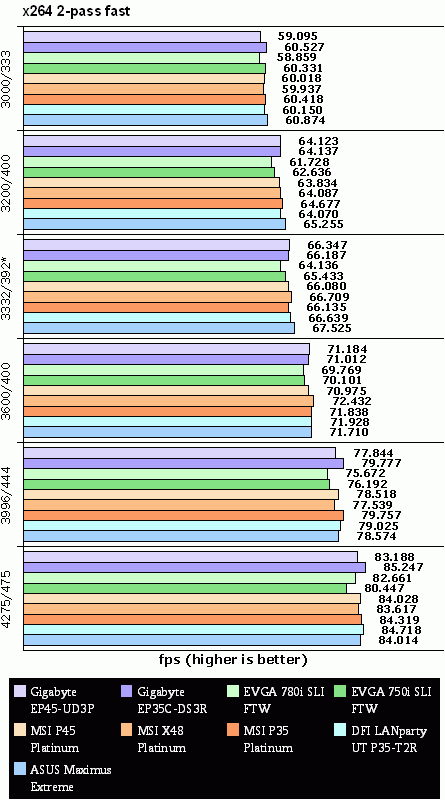
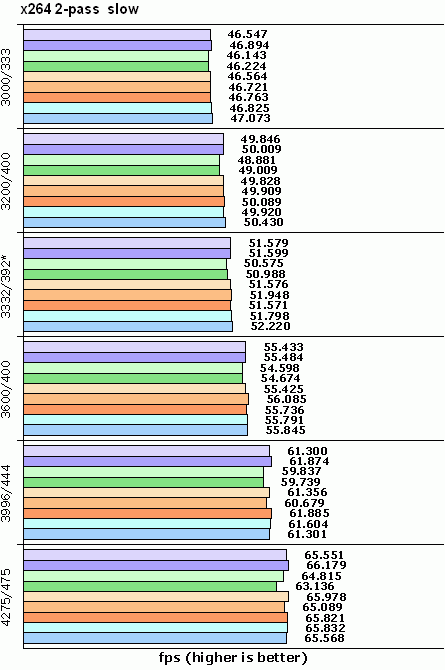
Note: The DFI P35 mainboard doesn't support half multipliers, so we used 417x8.
As you can see, the P45 chipset is slower compared to the P35, but the differences are very small and you won't notice them.
LameMT:
The same episode we encoded we used for our MP3-testing. We don't recommend using MP3 for encoding, because AC3 can do the job better, but nearly 42 minutes gives us approximately the length of any given album.
A measurement in seconds, as many sites do, is useless, because the differences are too small. So, we used the built-in play/CPU ratio, this means the CPU is encoding x-times faster then the track-length. Fast memory does not play an important role here. For your convenience we also show the single-threaded benchmarks figures, they can be re-produced with any version of L.A.M.E. Only LameMT can do multi-thread and take advantage of multi-core processors.
We used this setting: lamemt --vbr-new -q 2 -V 2 -m j --strictly-enforce-ISO --resample 48
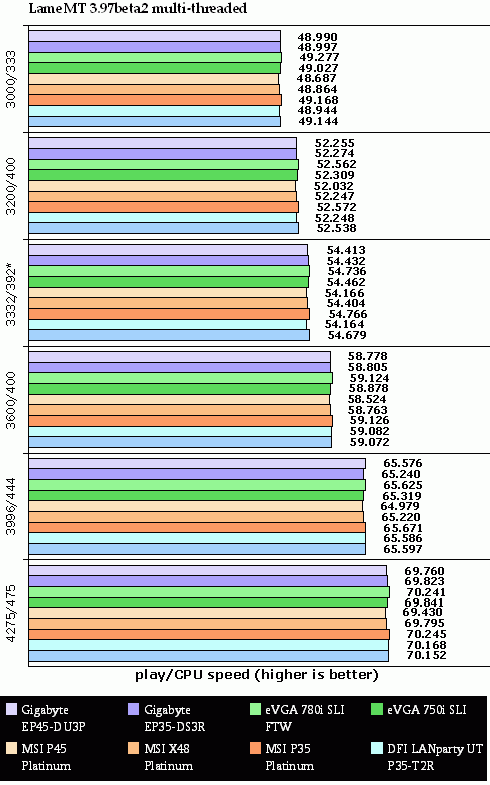

Note: The DFI P35 mainboard doesn't support half multipliers, so we used 417x8.
Same as x264, P45 is slower again, but nothing you should worry about.
Power-Consumption:
As expected, the board does very well. In idle the board does not as well as MSI, but beats its predecessor. Under load they are quite close. Still, the EP45 series does not catch the EP35, which is a bit disappointing.
Please note that other configurations may yield other results.
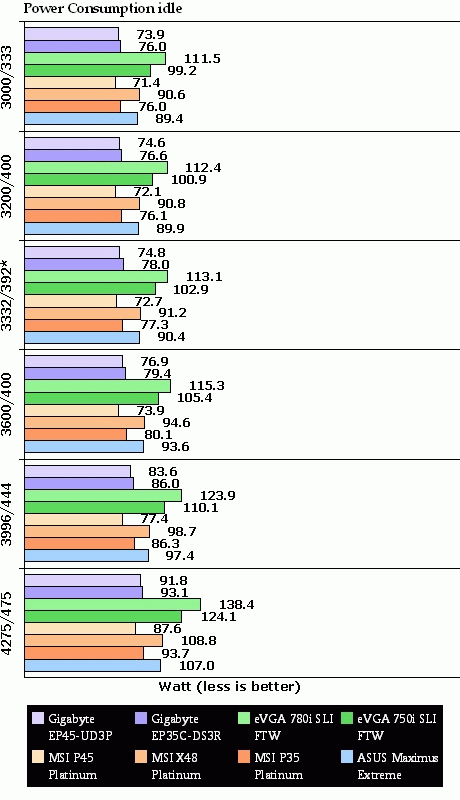
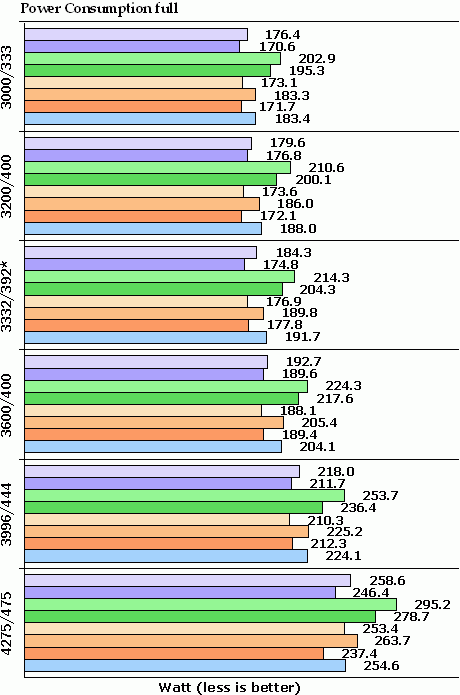
Conclusion
Gigabyte did a good job. The EP35 did yield some very nice results, but the EP45 UD3 series tops them, except when it comes to power consumption. It's a bit slower compared to the P35 series, but FSB 550MHz and DDR2 at 1333MHz are nice. The layout is good, too, except we miss the small power-on, reset and clear-cmos buttons, but you can manage without them. If you attempt overclocking which will fail to boot up your board, just power down; it will boot up the next time for sure.
This board is not a budget board and it's not a high-end board, either. For about €136,- you get a fine board with all the features you possibly need. It does its job as you will expect and it's BIOS is not messy, beside some lame settings, such as enabling COM and LPT.
For most users investing in a new Core i7 system will not be a viable option, because DDR2 prices have hit rock bottom and for gamers a dual-core will work just fine and they do overclock easily. Invest in a better graphics-card instead and if you think you need a quad-core go for one of the cheap Q8x00 series.
If you think to upgrade from an old system, that board is quite right for you and earns our Top Value Award.

